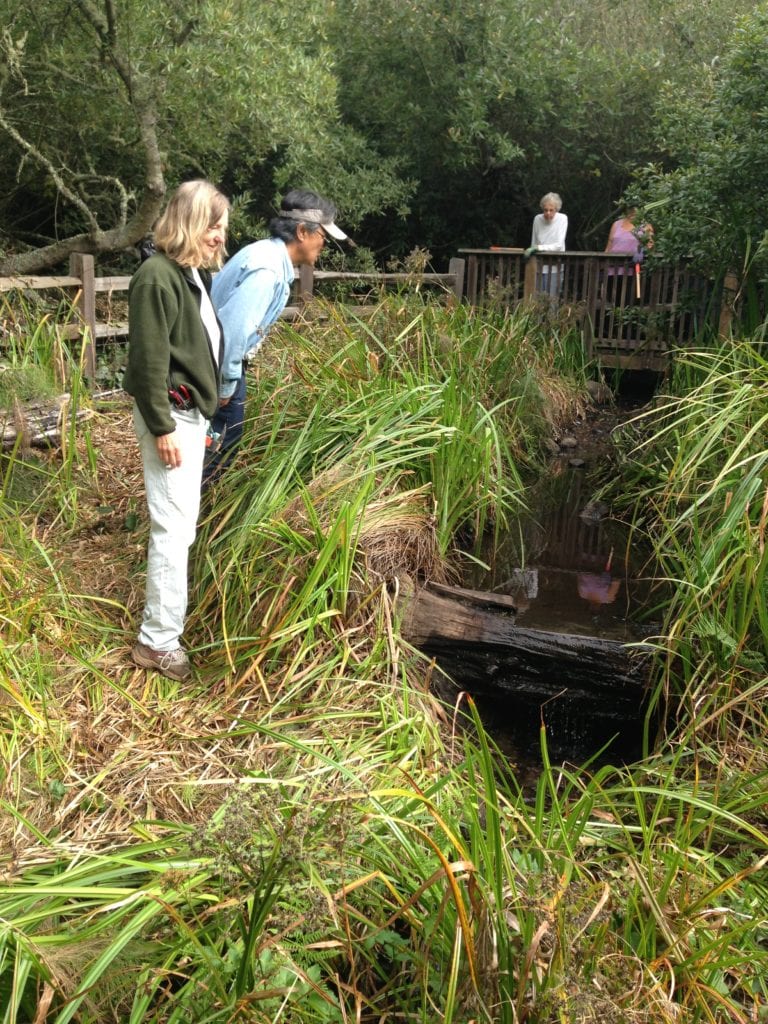
Stories and photos by Murray Schneider
Moses may have done well with bulrushes, but our creek does not. It’s not over fond of Cape ivy and Himalayan blackberry either. Which is why on two recent Wednesdays Friends of Glen Canyon Park volunteers dove in along the east side of Islais Creek.
Steve Uchida, a retired U.S. postal worker, and Kay Westerberg, a retired Herbert Hoover Middle School teacher, spent their time clearing the blurushes that were choking the stream.
Uchida lives on Monterey Boulevard. He donned a pair of calf-length Wellingtons for his attack. Westerberg, who resides on Chenery Street, carried a lopper, a mattock and a pruning clipper.
Under the eye of a Recreation and Parks Department Natural Areas Program gardener, Uchida began clearing Islais Creek of bulrushes . A few feet away, Westerberg started pruning overhanging Arroyo willow and removing invasive Cape ivy and Himalayan blackberry from the adjacent creek side.

Islais Creek begins at the rim of Glen Canyon and meanders through the 70-acre natural area, entering a culvert behind the Works Progress Administration-built Recreation Center. It runs for three miles unseen beneath the city and eventually gains daylight on the waterfront within walking distance of AT&T Park.
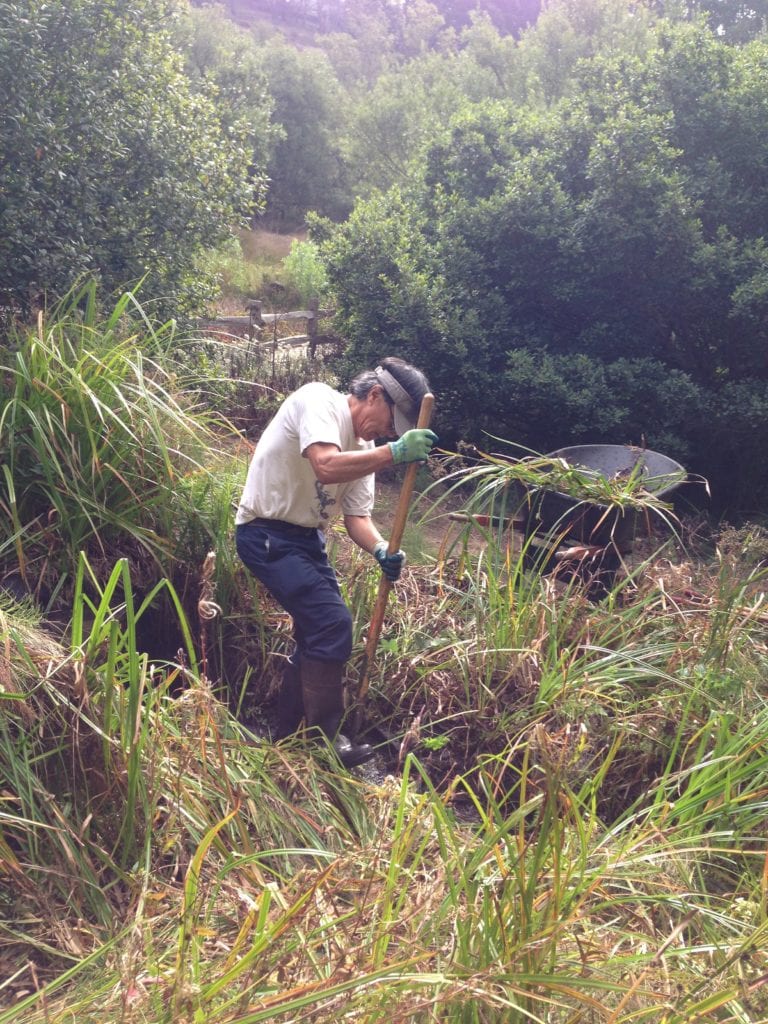
Infant Moses was supposed to have been found in a boat made of bulrushes, which flourish in wet places such as ponds, marshes, rivers and lakes. Such sedge stems were once used to weave mats, baskets and chair seats, and it’s not hard to imagine indigenous Ohlone once sitting along Islais Creek and engaging in such handicraft.
Uchida and Westerberg have worked together for several years, so they were familiar with the terrain. Jean Conner and Gloria Koch, two additional Glen Canyon volunteers, joined them on their second morning creek side. Another volunteer, Mary Huizinga, wandered the canyon expunging graffiti tags from willow trunks.
Rec and Park dubs the area Pool Two. It’s one of three sanctuaries the NAP manages, which teem with native plants such as Douglas iris, snowberry, creek dogwood, columbine, fern, coffee berry and pearly everlasting.
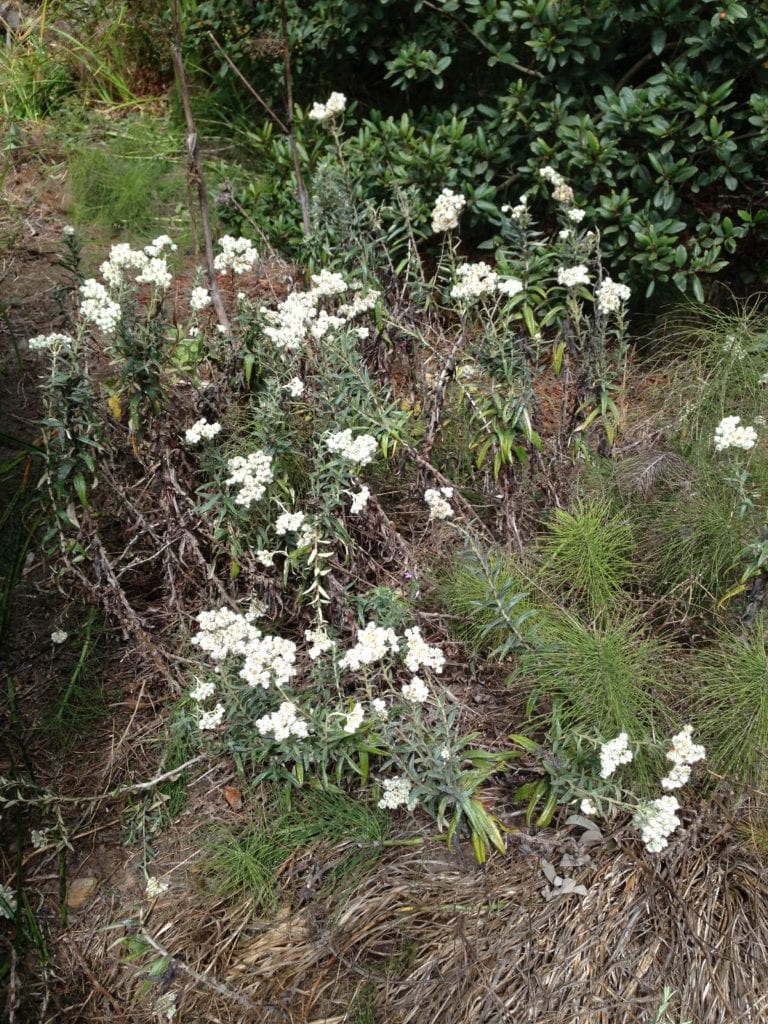
On the Wednesday mornings Uchida and Westerberg worked, the pearly everlasting flowered in necklaces of white puffy cotton balls. The native plants act like magnets. Each attracts butterflies, birds and bees, all major actors in a NAP scenario that envisions Glen Canyon’s urban wilderness as Technicolor habitat, but one that needs continued stewarding.
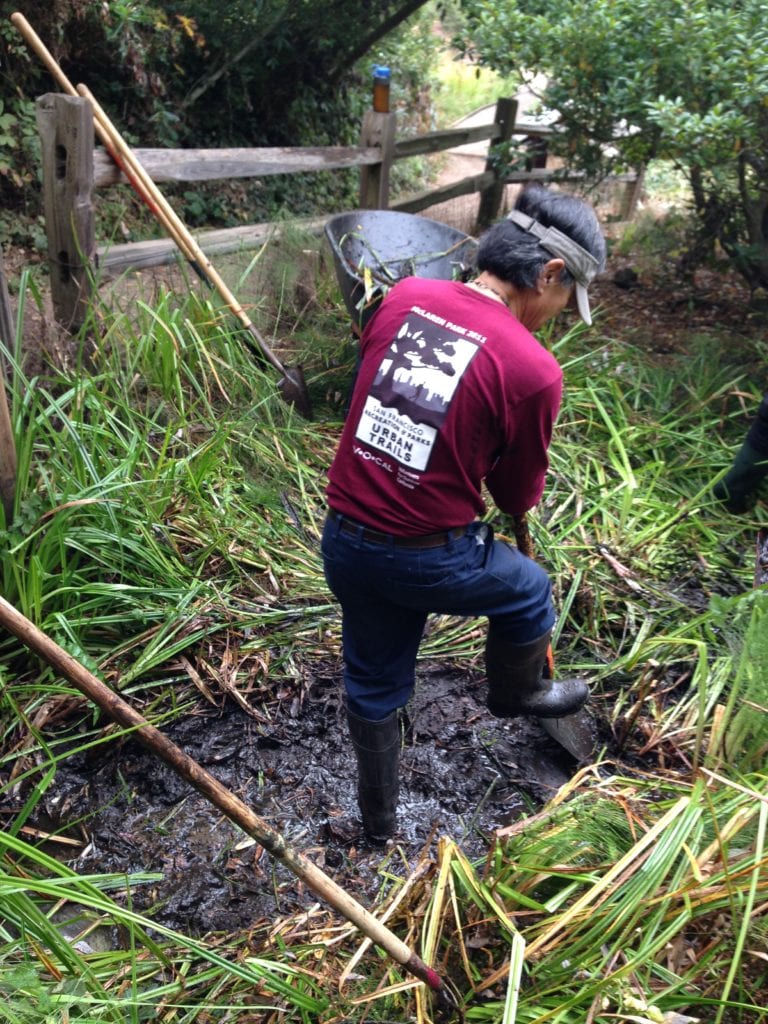
The creek, smothered with bulrush, stuttered in spits and starts. Left unmanaged, insects such as dragonflies wouldn’t be able to replenish themselves.
Early on, Uchida selected a rake, eased it into the stream and bent his back beside the NAP staffer who wielded a trenching shovel. She dug it deep into the sludge. The water had a dish water-tinge. Westerberg knelt in a thicket of ivy and began untangling Medusa-like tendrils. Eventually she turned her attention to grizzly willow, gnarly and braided. Lichens were shot gunned to the trees’ branches. Westerberg lopped limbs, eventually stuffing them, butt first, into the undergrowth.
Uchida’s rubber boots sloshed in the muck. He filled wheelbarrow after wheelbarrow with clusters of waterlogged leaf blades. His T-shirt, earlier Tide-clean, now adhered to his chest in muddy splotches. He inched his way along the creek, opening up a channel twenty feet long, now free to unleash liberated water.
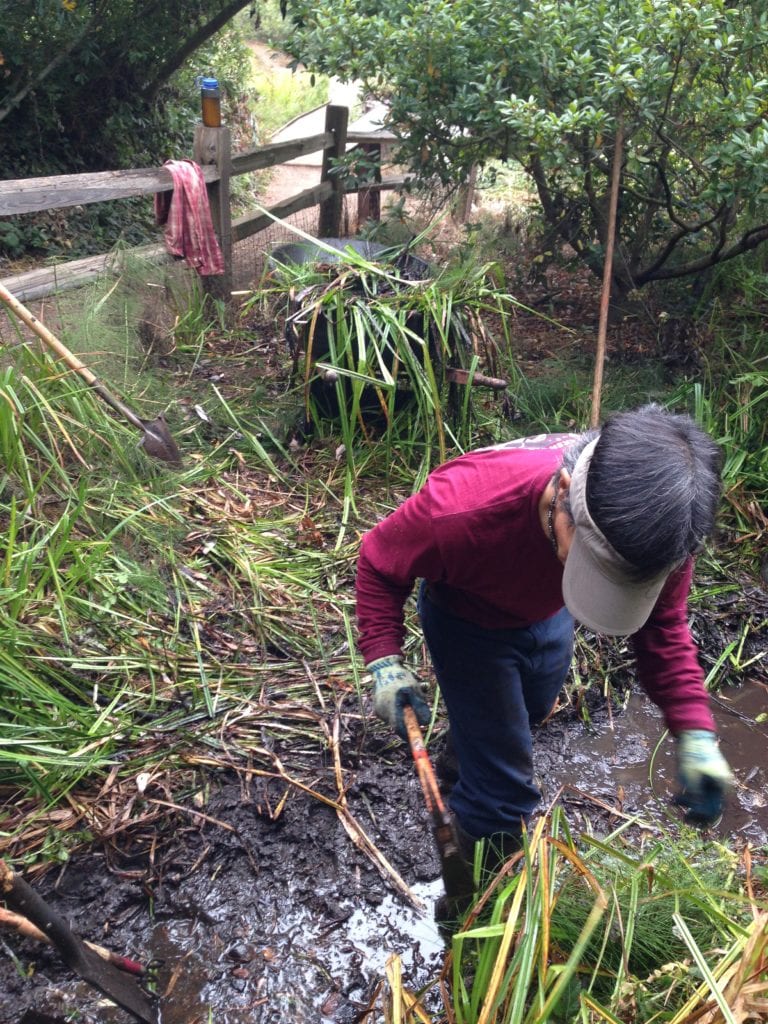 Westerberg put down her lopper and walked over.
Westerberg put down her lopper and walked over.
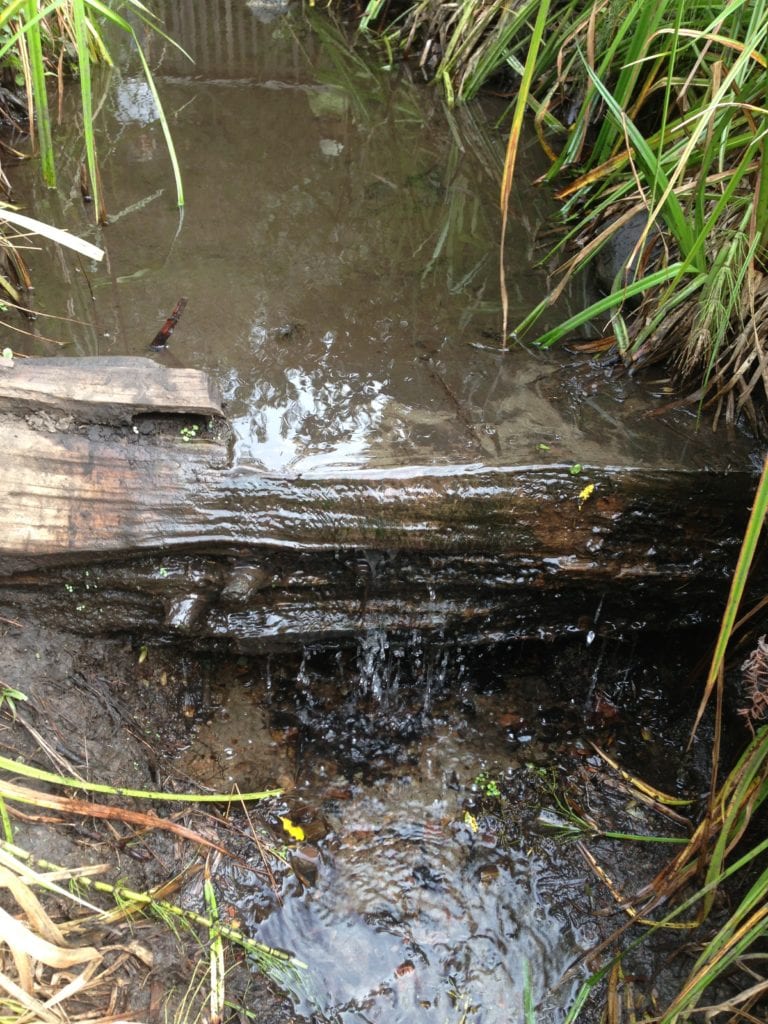
“It’s like a little waterfall,” she said. “It’s got a really nice sound to it now.”
Uchida listened, lifting his shoes from mud suction cups. No one could confuse the results of his efforts with the full-blown Stow Lake waterfall descending Strawberry Hill, but his mini-cascade now moved with alacrity.
“I’m going to introduce Steelhead trout,” he said with a wink.
“It’s flowing,” Westerberg winked back. “Let’s get the inner tubes!”
“It’s be our best-kept secret swimming hole,” said Uchida.
The morning had begun chilly and before the volunteers had gained the creek they’d spied dozens of pumpkin spider webs, auditioning for their Halloween debut, in the seep adjacent to a boardwalk. While they studied the nascent orbs, a larger dew-beaded web posed behind them, sunlight funneling through its geometric windows.
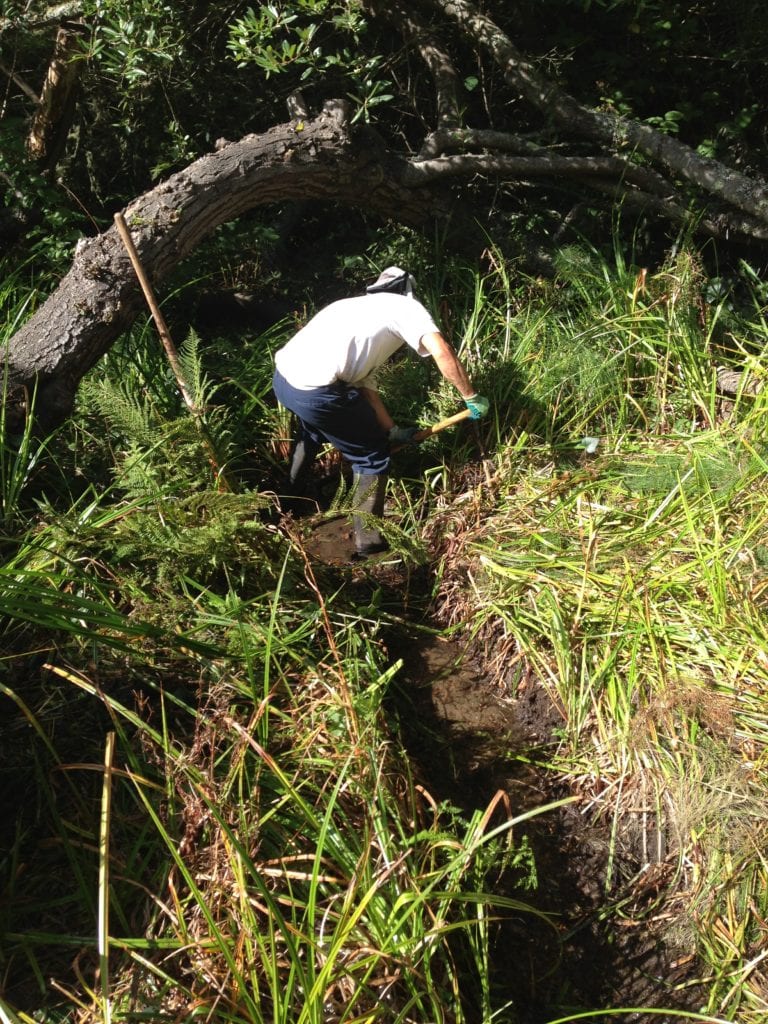
While Uchida combated the bulrushes a dog walker lingered along the railing, watching him. Surveying the scene, she volunteered that she’d roamed the canyon for 35 years. She could remember, she said, how a group of neighbors had stopped Sacramento from constructing a freeway through it, and how her house on Arbor Street was one of the first built on hills that had over a century ago reminded early Glen Park boosters that the neighborhood might best be called “Little Switzerland.”
One could only imagine how the discordant thrum of speeding automobiles and trucks would have clashed with the harmony of the emancipated stream, chortling now, flowing fast and sure.
Friends of Glen Canyon Park volunteers stash Maxwell House coffee tins beneath low-lying shrubs next to the now unencumbered stream. During dry years, they use the discarded cans to collect water, quenching the thirst of parched sticky monkey flower, pink flowering currant and holly leaf cherry.
Another dog walker, Cathleen O’Brien, who has lived on Conrad Street since 1986, followed her two dogs. She stopped and looked, too, as Uchida and the NAP gardener finished completing the remaining 32 feet of stream.
“A big thank you,” she said. “It’s a beautiful creek.”
Westerberg moved farther away, swallowed by a copse of willow and blackberry, past were Jean Conner pruned branches, and for a while she couldn’t be seen only heard.
“I found a place where animals den, probably coyotes,” Westerberg could be heard saying. “It’s among the rushes, all flattened out.”
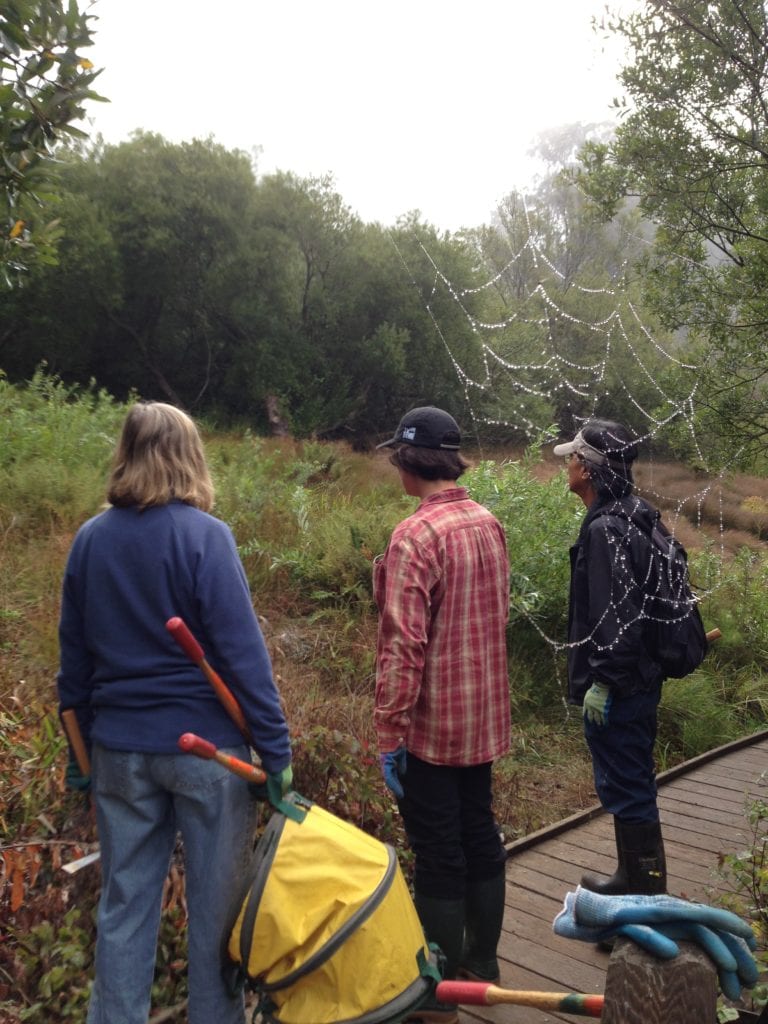
After finishing, Uchida put aside his tools. So did the others. Wiry and lithe, he stepped over the creek and retrieved a backpack and a pair of sunglasses. Westerberg followed him to the fence, trailed by Conner and Gloria Koch. Their NAP gardener, who surveyed the morning’s effort, brought up the rear.
“The creek’s day-lighted for damselflies,” she said, smiling.
“I hear them now,” said Steve Uchida, winking again, “The swimming pool’s open!”
